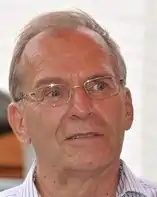Bernhard Walke
Bernhard H. Walke (born 28 July 1940 in Neisse, Upper Silesia) is a pioneer of mobile Internet access[1] and professor emeritus at RWTH Aachen University in Germany. He is a driver of wireless and mobile 2G to 5G cellular radio networks technologies. In 1985 he proposed a local cellular radio network[2] comprising technologies in use today in 2G, 4G and discussed for 5G systems. For example, self-organization of a radio mesh network, integration of circuit- and packet switching, de-centralized radio resource control, TDMA/spread spectrum data transmission, antenna beam steering, spatial beam multiplexing, interference coordination, S-Aloha based multiple access and demand assigned traffic channels, mobile broadband transmission using mm-waves, and multi-hop communication.[3]
Bernhard H. Walke | |
|---|---|
 Bernhard Walke at RWTH Aachen | |
| Born | 28 July 1940 |
In 1991, he proposed CELLPAC[4] for packet switching in GSM which triggered development of ETSI standard GPRS. GPRS air-interface protocols follow a 1993 version[5] of CELLPAC. In 1999 he proposed fixed two-hop decode-and-forward relays[6] for cellular radio, now mandatory in standards 3GPP LTE Rel.10 and IEEE 802.16.1 (mobile broadband WiMAX). The relay concept triggered evolution of cellular radio architecture towards 3GPP LTE Small Cell networks, e.g. femto and pico cells operating like relays on radio resources provided by a donor base station.
The Communications Networks (ComNets) research team in large parts designed the ETSI/BRAN HiperLAN2 medium access control protocol[7] adopted by standard IEEE 802.16 (WiMax) and used as a baseline in 3GPP LTE-Advanced. Radio spectrum requirements for packet-switching mobile radio systems were calculated by World Radio Conference 2007 using a queuing model[8] developed by Walke and his team.[9] Work by Walke and his team on wireless quality of service supporting multi-hop radio networks[10][11] materialized in standard IEEE 802.11s.
Walke earned his Dipl. Ing. (M.Sc.) degree in Electrical Engineering and Data Processing (1965) from University of Stuttgart, Germany. He worked two years as a trainee with Telefunken and joined Telefunken Research (1967) where he received his doctorate (1975) from University of Stuttgart. As a department head in 1983 at AEG Telefunken (later taken-over in part by Airbus), he moved to FernUniversität Hagen, Germany, as a professor for data processing techniques. During 1990-2007 he was professor and director of the School of Communications Networks (ComNets) at RWTH Aachen's Faculty of Electrical Engineering and Information Technology until 2017 where he was head of the ComNets Research Group.[12]
Awards
References
- Walke, Bernhard H.: The roots of GPRS: the first system for mobile packet-based global internet access, IEEE Wireless Communications, Volume: 20, Issue: 5, Page(s): 12-23, October 2013.
- Bernhard H. Walke and R. Briechle, A Local Cellular Radio Network for Digital Voice and Data transmission at 60 GHz Archived 2015-04-02 at the Wayback Machine, Proc. Cellular & Mobile Communications International, London, U.K., 5–7 November 1985, 215–225
- Pabst, R.; Walke, B. H.; Schultz, D. C.; Herhold, P.; Yanikomeroglu, H.; Mukherjee, S.; Viswanathan, H.; Lott, M.; Zirwas, W.; Dohler, M.; Aghvami, H. "Relay-based deployment concepts for wireless and mobile broadband radio". IEEE Communications Magazine. 42 (9): 80–89. doi:10.1109/MCOM.2004.1336724. ISSN 1558-1896.
- Bernhard H. Walke, W. Mende, G. Hatziliadis: CELLPAC: A Packet Radio Protocol Applied to the Cellular GSM Mobile Radio Network, In Proceedings of 41st IEEE Vehicular Technology Conference, Page(s): 408-413, St. Louis, Missouri, USA, May 1991.
- "A General Packet Radio Service Proposed for GSM: ComNets Research Group". Archived from the original on 2012-03-18. Retrieved 2017-08-14.
- Bernhard H. Walke, N. Esseling: "Method for the operation of wireless base stations for packet transfer radio systems having a guaranteed service quality", US 7095722 B1.
- Bernhard H. Walke, D. Petras, D. Plassmann: Wireless ATM: Air Interface and Network Protocols of the mobile Broadband System, IEEE Personal Communications Magazine, Vol. 3, 08/1996, 50-56
- H. Takagi, Bernhard H. Walke: "Spectrum Requirement Planning in Wireless Communications: Model and Methodology for IMT - Advanced", John Wiley & Sons, 2008, ISBN 978-0-470-98647-9.
- T. Irnich, Bernhard H. Walke: Spectrum Estimation Methodology for Next Generation Wireless Systems, Proc. IEEE Personal Indoors and Mobile Communications Conference, Berlin, Germany, September 2005
- R. Zhao, Bernhard H. Walke, and G. R. Hiertz: "An efficient IEEE 802.11 ESS mesh network supporting quality of service", IEEE Journal on Selected Areas in Communications, 24 (11), 2005-2017.
- G. R. Hiertz, D. Denteneer, S. Max, R. Taori, J. Cardona, L. Berlemann, and Bernhard H. Walke: "IEEE 802.11s: The WLAN Mesh Standard", IEEE Wireless Communications, February 2010, 104-111.
- http://www.elektrotechnik.rwth-aachen.de/cms/Elektrotechnik-und-Informationstechnik/Forschung/Institute/~qsj/Professoren/ (see end of page).
- "Introducing the 2016 Class of Fellows". the institute. 2016-03-14. Retrieved 2018-01-29.
- https://www.ieee.org/membership_services/membership/fellows/fellowsDirectory.html# (search in database for year 2016, and for letter "W").
- "Preis der ITG - VDE|ITG".